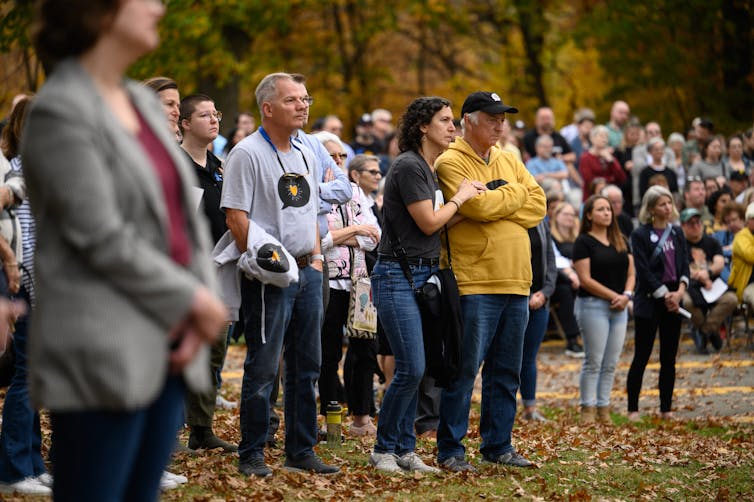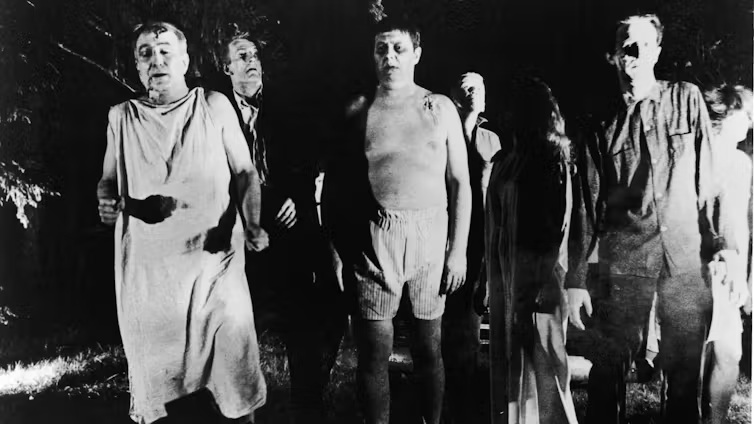Horror teaches us that we are the zombies. Pictorial Parade via Getty Images
by Adam Lowenstein, University of Pittsburgh
The Halloween season has always been special for me. It’s the time when it seems the entire country shares the fascination with the dark side of human experience that has inspired me from my youth as a fan of horror movies to my current career as a professor of English and film studies focused on the horror genre.
I’m a member of Pittsburgh’s Jewish community, and the Halloween season has also carried a very different connotation for the past seven years. On Oct. 27, 2018, Pittsburgh’s Tree of Life synagogue was the site of the deadliest antisemitic attack in American history.
Tree of Life is less than 2 miles from my home, and the Jewish congregation that I belong to was one of the three congregations holding Shabbat services in the building at the time of the attack. Several members of my congregation were killed or wounded.
At the time, I was teaching a graduate seminar on horror films at the University of Pittsburgh. I wasn’t sure I could go on with the course. How could I continue teaching a class about imaginary horror when real horror had come home in such a brutally devastating way?
But after I began to work through my most visceral feelings of sadness, rage and fear, I realized that the seminar was more urgent than ever.
After all, what horror studies teaches us is that the truly monstrous things in our world are not zombies, vampires or demons, but beliefs that reduce our fellow human beings to something less than fully human.
Lessons from the living dead
The most influential film ever produced in Pittsburgh is George A. Romero’s 1968 “Night of the Living Dead.”
In that horror classic, which celebrated its 50th anniversary the same month as the Tree of Life killings, the true threats are not the zombies that rise from the dead to eat the flesh of the living.
The real danger comes from within, where a houseful of survivors under siege from the zombies outside cannot get beyond their own differences and disagreements to help each other escape.
They all die, so the only people who will ever know the difference between the human protagonists and the undead zombies surrounding them are us – the audience that has witnessed it all. And given what we have seen, we wonder: Why do the humans fail to get along with each other so spectacularly, while the zombies have no trouble working together as a team of equals?
We are the zombies
Romero, the film’s director and co-writer, suggests an answer to this question that is at the heart of horror studies: The zombies are us.
They are not our enemies or our opposites or our others. They are the living dead, and so are we.
All of us will die eventually, so we are all the living dead by definition. But over and over again, humankind struggles to see those around them who do not share their same religion, color or political beliefs as something other, something less human. And sometimes, something to destroy.
At the close of “Night of the Living Dead,” Ben is the last protagonist to survive. When dawn breaks, Ben hears the voices of his rescuers outside. But before he can call out to them, they shoot him dead. He has been mistaken for a zombie, and his corpse will join those of the other zombies burning in a bonfire.
This ending would be shocking in any register, but the fact that Ben is the film’s sole Black character and that his would-be rescuers are an all-white posse of trigger-happy militiamen delivers a truly shattering blow.
Romero completed the film before the assassination of Martin Luther King Jr., but audiences did not see “Night of the Living Dead” until afterward. So when the shot rings out that kills Ben, it would have been nearly impossible in 1968 to not think about King.

Facing real-world atrocities
The best horror films are about facing the truth, no matter how painful or even traumatic. In my 2005 book “Shocking Representation: Historical Trauma, National Cinema, and the Modern Horror Film,” I write about how different horror films throughout the decades have demanded that we engage horrific historical events we might prefer to evade.
For example, “Eyes Without a Face” can be viewed as an implicit commentary on the German occupation of France, “Onibaba” on the atomic bombing of Hiroshima, and “The Last House on the Left” on the American cultural crises around the Vietnam War.
It would have been easier for me to blame the Tree of Life killings on an otherworldly monster: a lone, antisemitic lunatic classifiable as a demonic anomaly. But that gunman didn’t come from some fantasy planet of zombies and vampires. He came from this world, the one all of us live in, the one that all of us are obligated to contribute toward shaping and repairing.
“Night of the Living Dead” was explaining that back in 1968. In 2018, I took strength from those lessons. I persisted with teaching my horror film seminar in a way that aimed to honor the awful reality of the Tree of Life killings, rather than turn away from it.
When my students discussed “Night of the Living Dead,” I asked them: Who killed Ben, really? Not the zombies. Not his rivals in the besieged house. In a certain sense, we all participated in Ben’s death. All of us watched it happen, and we are the only ones who will ever know the truth about his fate.
As Halloween arrives once again, the Tree of Life synagogue is still a half-demolished construction site. But I remain hopeful about horror’s invitation to confront the anguish of our world’s most traumatic events and commit to a world where better things are possible.
Adam Lowenstein, Professor of Film and Media Studies, University of Pittsburgh
This article is republished from The Conversation under a Creative Commons license. Read the original article.

